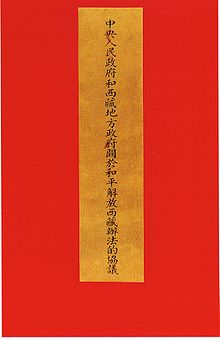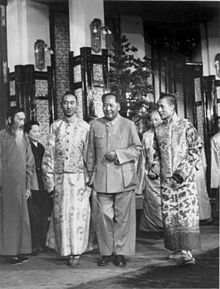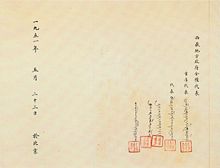- Seventeen Point Agreement for the Peaceful Liberation of Tibet
-
Agreement of the Central People's Government and the Local Government of Tibet on Measures for the Peaceful Liberation of Tibet 
Traditional Chinese 中央人民政府和西藏地方政府關於和平解放西藏辦法的協議 Simplified Chinese 中央人民政府和西藏地方政府关于和平解放西藏办法的协议 Transcriptions Mandarin - Hanyu Pinyin Zhōngyāng rénmín zhèngfǔ hé Xīzàng dìfāng zhèngfǔ guānyú hépíng jiěfàng Xīzàng bànfǎ de xiéyì Cantonese (Yue) - Jyutping zung1 joeng1 jan4 man4 zing3 fu2 wo4 sai1 zong6 dei6 fong1 zing3 fu2 gwaan1 jyu1 wo4 ping4 gaai2 fong3 sai1 zong6 baan6 faat3 dik1 hip6 ji5 Seventeen point plan Traditional Chinese 十七條協議 Simplified Chinese 十七条协议 Transcriptions Mandarin - Hanyu Pinyin Shíqī tiáo xiéyì Cantonese (Yue) - Jyutping sap6 cat1 tiu4 hip6 ji5 The Agreement of the Central People's Government and the Local Government of Tibet on Measures for the Peaceful Liberation of Tibet, or the Seventeen Point Agreement for the Peaceful Liberation of Tibet for short, is the document by which the ersatz[clarification needed] delegates of the 14th Dalai Lama allegedly reached an agreement with the government of the newly-established People's Republic of China on affirming Chinese sovereignty over Tibet. It was signed by Ngapoi Ngawang Jigme, who advocated Tibetan acquiescence to China, and sealed in Beijing on 23 May 1951 and confirmed by the government in Tibet a few months later.[1] In addition, the following letter purportedly written by the Dalai Lama indicating his acceptance was also sent to Beijing in the form of a telegram on the 24th of October. Some say that the delegates were coerced to sign the agreement, others insist that it actually never happened:
"The Tibet Local Government as well as the ecclesiastic and secular people unanimously support this agreement, and under the leadership of Chairman Mao and the Central People's Government, will actively support the People's Liberation Army in Tibet to consolidate national defence, drive out imperialist influences from Tibet and safeguard the unification of the territory and the sovereignty of the Motherland." [2]
According to the Tibetan government-in-exile, some members of the Tibetan Cabinet (Kashag), for example, Tibetan Prime Minister Lukhangwa, never accepted the agreement.[3] But the National Assembly of Tibet, "while recognizing the extenuating circumstances under which the delegates had to sign the 'agreement', asked the government to accept the 'agreement'...the Kashag told Zhang Jingwu that it would radio its acceptance of the 'agreement'."[4]
Chinese sources regard the document as a legal contract that was mutually welcomed by both governments and by the Tibetan people. Tibetan exile sources and international governments generally consider it invalid, as having been reluctantly or unwillingly signed under duress.[5]
On the path that was leading him into exile in India, the 14th Dalai Lama arrived March 26, 1959 at Lhuntse Dzong where he repudiated the "17-point Agreement" as having been "thrust upon Tibetan Government and people by the threat of arms."[4] and reaffirmed his government as the only legitimate representative of Tibet.[6][7]
Contents
Lead up
The People's Liberation Army crossed the Jinsha River on 6 or 7 October 1950 and had defeated the Tibetan army by 19 October.[8][9] Instead of continuing with the military campaign, China asked Tibet to send representatives to Beijing to negotiate an agreement. The draft agreement was written by China, and Tibetan representatives were not allowed to suggest any alterations. China did not allow the Tibetan representatives to communicate with Lhasa. The Tibetan delegation was not authorized by Lhasa to sign, but ultimately submitted to pressure from the Chinese to sign anyway, using seals which had been specifically made for the purpose.[10]
The signing of the Seventeen-Point agreement was later contested as invalid in the Tibetan exile community, who charged that the Tibet delegates were forced to sign under duress and that the Chinese allegedly used forged Tibetan government seals. The exile community and their supporters continue to assert that the Tibetan representatives were not allowed to suggest any alterations and that the Chinese government did not allow the Tibetan representatives to communicate with Lhasa.[10]
However, Tibetologist Melvyn Goldstein, who interviewed at least two negotiators and the only interpreter (the Dalai Lama's brother-in-law) from the Tibetan side, provides a different account:
“ The Chinese did make new seals for the Tibetans, but these were just personal seals with each delegate's name carved on them. Other than this, there were no forged government seals. Part of the confusion derives from the fact that Ngabo had in his possession the seal of the governor of Eastern Tibet but chose not to use it. That seal, however, was not the official seal of the Tibetan government, so not using it did not lessen the validity of the agreement. In his autobiography, the Dalai Lama states that the Tibetan delegates claimed they were forced 'under duress' to sign the agreement...
Their feeling of duress derives from the general Chinese threat to use military force again in Central Tibet if an agreement was not concluded. However, according to international law, this does not invalidate an agreement. So long as there is no physical violence against the signatories, an agreement is valid. However, the validity of the agreement is premised on the signatories' full authority to finalize an agreement, and this, as we saw was clearly not the case. So in this sense, the Dalai Lama actually had grounds to disavow it.[11]” And, as a Tibetan negotiator recalled, instances indeed exist when the Tibetan delegates, with Dalai Lama's authorization,[12] were free to suggest alteration.[13]
Delegates
Signed and sealed by delegates of the Central People's Government with full powers:
Chief Delegate:
- Li Wei-han (Chairman of the Commission of Nationalities Affairs);
Delegates:
- Chang Ching-wu, Chang Kuo-hua, Sun Chih-yuan
Delegates with full powers of the Local Government of Tibet:
- Chief Delegate: Ngapoi Ngawang Jigme
Delegates:
- Dzasak Khemey Sonam Wangdi, Khentrung Thuptan, Tenthar, Khenchung Thuptan Lekmuun Rimshi, Samposey Tenzin Thondup
The seventeen points
- The Tibetan people shall unite and drive out imperialist aggressive forces from Tibet; the Tibetan people shall return to the big family of the Motherland the People's Republic of China (PRC).
- The local government of Tibet shall actively assist the PLA to enter Tibet and consolidate the national defences.
- In accordance with the policy towards nationalities laid down in the Common Programme of the Chinese People's Political Consultative Committee, the Tibetan people have the right of exercising national regional autonomy under the unified leadership of the CPG.
- The central authorities will not alter the existing political system in Tibet. The central authorities also will not alter the established status, functions and powers of the Dalai Lama. Officials of various ranks shall hold office as usual.
- The established status, functions and powers of the Panchen Ngoerhtehni shall be maintained.
- By the established status, functions and powers of the Dalai Lama and of the Panchen Ngoerhtehni are meant the status, functions and powers of the thirteenth Dalai Lama and the ninth Panchen Ngoerhtehni when they had friendly and amicable relations with each other.
- The policy of freedom of religious belief laid down in the common programme of the CPPCC shall be carried out. The religious beliefs, customs and habits of the Tibetan people shall be respected and lama monasteries shall be protected. The central authorities will not effect a change in the income of the monasteries.
- Tibetan troops shall be reorganised step by step into the PLA and become a part of the defence force of the PRC.
- The spoken and written language and school education of the Tibetan nationality shall be developed step by step in accordance with the actual conditions in Tibet.
- Tibetan agriculture, livestock raising, industry and commerce shall be developed step by step and the people's livelihood shall be improved step by step in accordance with the actual conditions in Tibet.
- In matters relating to various reforms in Tibet, there will be no compulsion on the part of the central authorities. The local government of Tibet shall carry out reforms of its own accord, and, when the people raise demands for reform, they shall be settled by means of consultation with the leading personnel of Tibet.
- In so far as former pro-imperialists and pro-Kuomintang [Guomindang] officials resolutely sever relations with imperialism and the Kuomintang [Guomindang] and do not engage in sabotage or resistance, they may continue to hold office irrespective of their past.
- The PLA entering Tibet shall abide by all the above-mentioned policies and shall also be fair in all buying and selling and shall not arbitrarily take a needle or thread from the people.
- The CPG shall have centralised handling of all external affairs of the area of Tibet; and there will be peaceful co-existence with neighbouring countries and establishment and development of fair commercial and trading relations with them on the basis of equality, mutual benefit and mutual respect for territory and sovereignty.
- In order to ensure the implementation of this agreement, the CPG shall set up a Military and Administrative Committee and a Military Area HQ in Tibet and - apart from the personnel sent there by the CPG - shall absorb as many local Tibetan personnel as possible to take part in the work. Local Tibetan personnel taking part in the Military and Administrative Committee may include patriotic elements from the local government of Tibet, various districts and various principal monasteries; the name list shall be set forth after consultation between the representatives designated by the CPG and various quarters concerned and shall be submitted to the CPG for appointment.
- Funds needed by the military and Administrative Committee, the Military Area HQ and the PLA entering Tibet shall be provided by the CPG. The local government of Tibet should assist the PLA in the purchase and transport of food, fodder and other daily necessities.
- This agreement shall come into force immediately after signature and seals are affixed to it.
Notes
- ^ Goldstein 1989, pp. 812–813
- ^ Shakya 1999 p. 90
- ^ In 1952 Lukhangwa told Chinese Representative Zhang Jingwu "It was absurd to refer to the terms of the Seventeen-Point Agreement. Our people did not accept the agreement and the Chinese themselves had repeatedly broken the terms of it. Their army was still in occupation of eastern Tibet; the area had not been returned to the government of Tibet, as it should have been." My Land and My People, Dalai Lama, New York, 1992, p.95
- ^ a b "The 17-Point Agreement" The full story as revealed by the Tibetans and Chinese who were involved
- ^ Powers 2004, pp. 116–7
- ^ Michel Peissel, "The Cavaliers of Kham, the secret war in Tibet" London: Heinemann 1972, and Boston: Little, Brown & Co. 1973
- ^ Dalai Lama, Freedom in Exile Harper San Francisco, 1991
- ^ Shakya 1999 pp. 32-45.
- ^ Goldstein 1997 p. 45
- ^ a b Powers 2004, pp. 113–6
- ^ Goldstein, Melvyn C., A History of Modern Tibet (Vol 2): A Calm before the Storm: 1951–1959, 2007, pp. 106–107
- ^ Goldstein, Melvyn C., A History of Modern Tibet (Vol 2): A Calm before the Storm: 1951–1959, 2007, p. 96
- ^ Goldstein, Melvyn C., A History of Modern Tibet (Vol 2): A Calm before the Storm: 1951–1959, 2007, pp. 101–102
See also
- Incorporation of Tibet into the People's Republic of China
- Foreign relations of Tibet
- History of Tibet
- Tenzin Gyatso, 14th Dalai Lama
References
- Goldstein, Melvyn C. A History of Modern Tibet, 1913–1951: The Demise of the Lamaist State (1989) University of California Press. ISBN 978-0520061408
- Powers, John. History as Propaganda: Tibetan Exiles versus the People's Republic of China (2004) Oxford University Press. ISBN 978-0195174267
- Shakya, Tsering. The Dragon In The Land Of Snows (1999) Columbia University Press. ISBN 0-231-11814-7
External links
- A translation of the full text including preamble of the agreement on tibetjustice.org
- A translation of the full text including preamble of the agreement on china.org
- The Tibetan View of the Seventeen Point Agreement – Central Tibetan Administration
- The Chinese View of the Seventeen Point Agreement – China Tibet Information Center
Categories:
Wikimedia Foundation. 2010.


